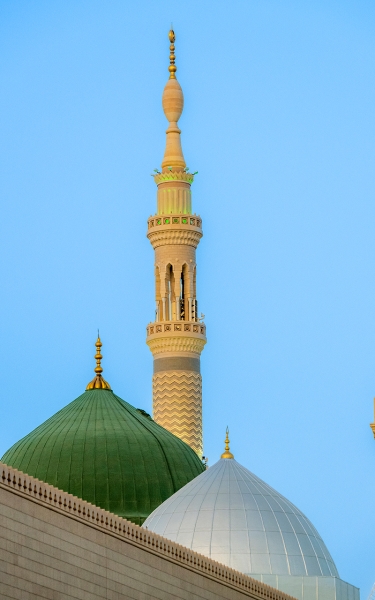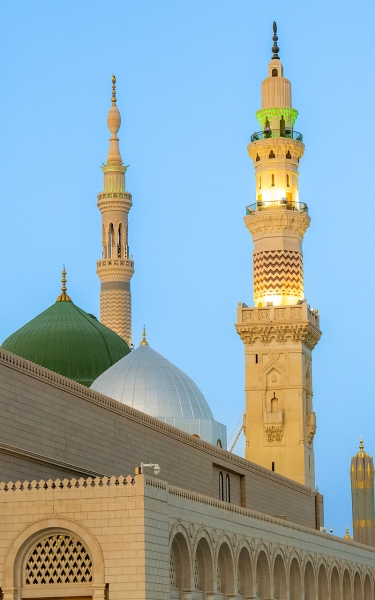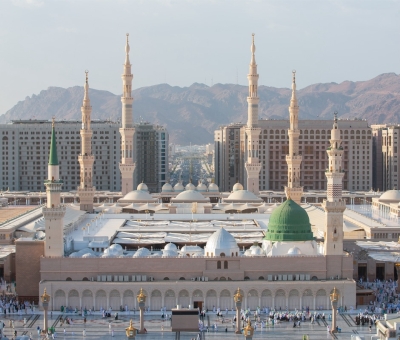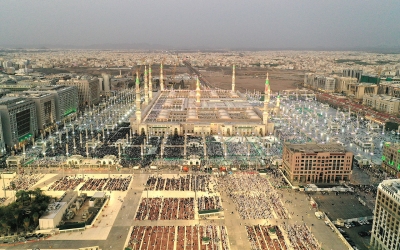


The Call to Prayer in the Prophet's Mosque refers to the adhan or call to prayer in the Prophet's Mosque in al-Madinah al-Munawwarah. The adhan is heralded by muezzins, who announce the call to prayer, announce iqamah (announce the prayer is about to commence), re-echo imams, and raise the call for funeral prayers, as well for prayers of Tarawih and Tahajjud (night prayer), al-Istisqa (Rain) Prayer, Eid al-Fitr and Eid al-Adha prayers, and Khusuf and Kusuf (lunar and solar eclipse) prayer.
Raising the call to prayer in the Prophet's Mosque
The adhan in the Prophet's Mosque is announced by the muezzins through the mosque's Mukabbiriya. It is the designated location for the muezzin to announce the call to prayer, iqamah, echo the imam of the mosque during prayer, and Eid Takbeer. The Mukabbiriya is a square bench situated approximately five m away from the minbar andelevated from the ground by eight columns, covering an area of 5 by 4 m. It was last renovated in 1983. It is an elevated, unroofed space overlooking al-Rawda al-Sharifa and the Prophet's Mosque's mihrab.
Managing the affairs of imams and muezzins in the Prophet’s Mosque
The Affairs of Imams and Muezzins in the Prophet's Mosque, affiliated with the General Presidency of Haramain, managed adhan in the Prophet's Mosque before the General Presidency of the Grand Mosque and the Prophet's Mosque was founded and entrusted with that responsibility. Responsibilities include preparing loudspeakers before prayer, testing their readiness and performance, and delivering the services and needs of imams and muezzins.
History of the call to prayer in the Prophet's Mosque
The call to prayer was not established when the Prophet's Mosque was built in the time of Prophet Mohammed (PBUH). He called among the community that prayer was underway, prompting people to assemble at the mosque to engage in the prayer rituals without the need for adhan or iqamah.
The call to prayer at the Prophet's Mosque occurred simultaneously with the change in the direction of the qibla towards the Grand Mosque rather than al-Aqsa Mosque. It was initiated by a shared vision of two companions, Abdullah Bin Zaid al-Khazraji and Umar Bin al-Khattab (may Allah's blessings be upon them). The Prophet (PBUH) verified this vision as rightful and subsequently instructed Bilal Bin Rabah to call people to prayer, which still resonates throughout all Muslim mosques today.
The Muslims engaged in discussions about methods to gather people for prayer. Some suggested the use of a trumpet, while others favored a bell. Abdullah Bin Zaid approached the Prophet and said: "Last night, I had a dream. I saw a man wearing two green garments, carrying a bell. I said to him, 'Will you sell the bell?' He answered; 'What will you do with it?' He said, "I will call (the people) to prayer." He replied, "Shall I not tell you of something better than that?" He said, "I said, What is it?" He replied to say 'Allah Akbar, Allah Akbar, until the end of the call to prayer. The Prophet (PBUH) said, "Go out with Bilal to the mosque and teach it to him, for he has a louder voice than you."
History of the Prophet's Mosque minarets
The first minaret in the Prophet’s Mosque was built by Umar Bin Abdulaziz during the reign of Caliph al-Walid Bin Abd al-Malik. A minaret was placed in every corner of the mosque. However, during the reign of Suleiman Bin Abd al-Malik, the number of minarets was reduced to three. The minarets remained until 1184. Among these, the eastern minaret had a distinctive silo-like appearance, while the remaining two took the form of towers.
Sultan al-Ashraf Qaitbay erected a small minaret, known as Bab al-Rahma (Door of Mercy) minaret, positioned between Bab al-Salam (Door of Peace) and Bab al-Rahma (Door of Mercy). During the Ottoman era, the northeastern minaret was dismantled and replaced with one named Sulaymaniyah. Subsequently, during Sultan Abdulmejid's expansion of the Prophet's Mosque, a fifth minaret was added, resulting in the erection of the northwestern minaret, referred to as Tashkeliya or Khashabiya (wooden). This minaret was also known as the Majidiya. However, it was removed during the first Saudi expansion, and a modern-style minaret was constructed in its place.
The northeastern minaret was known as the Sinjari minaret, as well as the Sulaymaniyah and Aziziyah. The southeastern minaret, referred to as the main minaret, retains this name today. Situated next to the Green Dome, the Kingdom is committed to its upkeep and periodic renovation and maintenance. The southwestern minaret bears the name Bab al-Salam (Door of Peace) minaret. The western lighthouse, known as the Bab al-Rahma (Door of Mercy) minaret, stands adjacent to the Muhammadiyah School, constructed outside the walls of the Prophet’s Mosque.
Related quizzes

